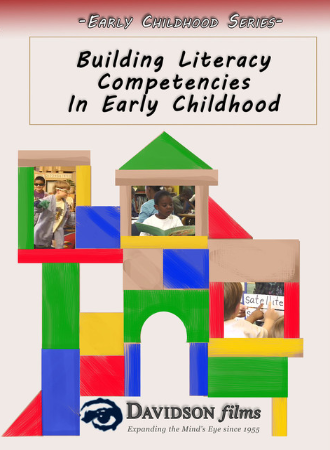
Building Literacy Competencies in Early Childhood 2000
Distributed by Davidson Films, Inc., 735 Tank Farm Rd, Suite 210, San Luis Obispo, CA 93401; 888-437-4200
Produced by Davidson Films
Directed by John M. Davidson
VHS, color, 30 min.
High School - Adult
Education, Psychology
Date Entered: 11/09/2018
Reviewed by Cindy Ehlers, Lockwood Library, University at BuffaloLiteracy is important for people of all ages, but it is especially critical to introduce literacy competencies in the first four or five years of life. Written and narrated by Deborah J. Leong, Ph.D. and Elena Bodrova, Ph.D., Building Literacy Competencies in Early Childhood examines the underlying cognitive, social and physical requirements for formal education, and then focuses on the literacy specific understandings and skills. This program highlights the precursors of reading and shows how they grow from appropriate practices and play provided by caring adults.
Organized into two sections, this video demonstrates both the underlying cognitive competencies necessary for all formal education as well as the literacy specific competencies, through the use of video clips shot in preschool, kindergarten, and after school care classrooms. The underlying cognitive competencies are oral language frequency, fine motor coordination, symbolic thought, one-to-one correspondence, and self-regulation skills. The importance of dramatic play is stressed as a way in which all of the above competencies can best be learned. Literacy specific competencies are divided into two subgroups: communicative aspects of literacy and literacy skills. The communicative aspects are purpose of reading, concepts of print, and comprehension of text; literacy skills include phonological awareness, letter recognition, alphabetic principle, sound/symbol correspondence and encoding/decoding. It is extremely important that classrooms as well as homes nurture both sets of competencies in an integrated way.
Through the use of graphics, video clips and narrative, this program covers the joint research by Leong and Bodrova in a clever and interesting way. At times Dr. Bodrova's accent made it difficult to understand the narrative and some of the office shots with Leong and Bodrova were fuzzy. While there are other programs on literacy and early childhood education, none of them focus on the various competencies that are often cited, but not always sufficiently explained. This video is recommended for an academic library's collection that supports courses in the fields of early childhood education and/or psychology.